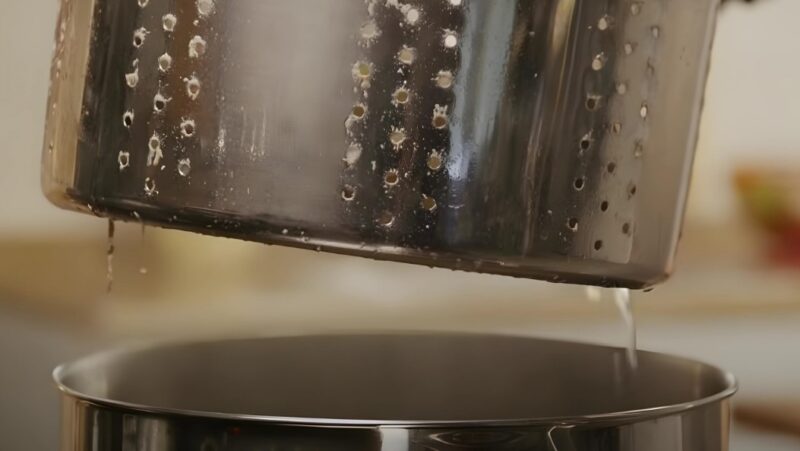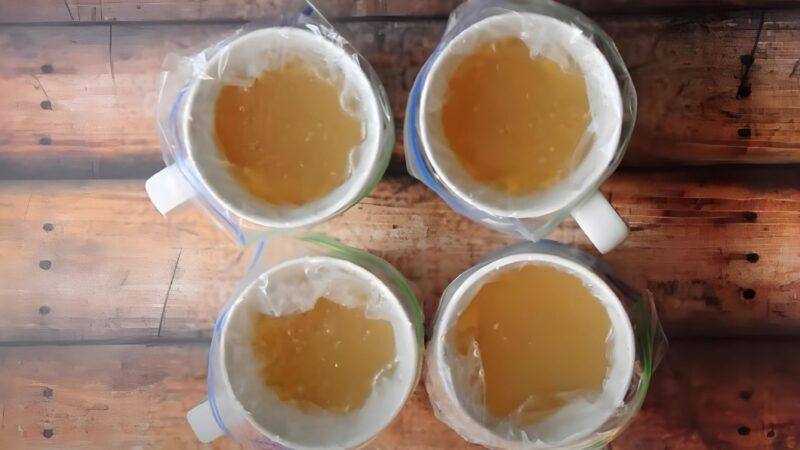Storing bone broth correctly is crucial for preserving its nutritional value, preventing spoilage, and ensuring safety. Proper storage extends shelf life, inhibits bacterial growth, and maintains the broth’s rich flavor. It also allows for convenient usage, enabling you to incorporate bone broth into your meals with ease.
This careful approach ensures that the broth remains a healthy and delicious addition to your diet.
Key Takeaways
- Before storing bone broth, cool it properly, strain it, and divide it into portions.
- Glass jars, plastic containers, freezer-safe bags, and vacuum-sealed bags are recommended for storing.
- Freezing bone broth significantly extends its shelf life. If frozen properly, it can last up to 6 months without losing quality.
How to Prepare Bone Broth for Storage?

Step 1 – Cooling Properly
Cool the broth quickly to minimize bacterial growth. This can be achieved by placing the pot in a sink filled with ice water and stirring the broth to expedite cooling. Ensuring the broth reaches a safe temperature quickly is crucial for food safety.
Transferring the cooled broth to the refrigerator or freezer promptly further inhibits any bacterial development.
Step 2 – Straining

Strain the broth to remove impurities and fat for a clearer, quality broth. Using a fine mesh strainer or cheesecloth ensures that the final product is free from unwanted particles and fat, which can spoil the flavor and appearance.
This step also contributes to a more digestible and aesthetically pleasing broth, making it more enjoyable to consume.
Step 3 – Portioning
Divide the broth into convenient serving sizes for easier use. This not only helps in managing consumption but also in reducing waste by thawing only the amount needed at a time. Portioning beforehand simplifies meal preparation, making it quicker and more efficient to incorporate bone broth into your diet.
Choose the Right Container

| Container Type | Advantages | Considerations |
| Glass Jars | – Durable and non-reactive
– Airtight seal – Easy to assess contents – Reusable and eco-friendly – Minimizes flavor transfer |
– Heavier than plastic
– Can break if dropped |
| Plastic Containers | – Lightweight and convenient
– Great for freezing – Easily stacked – Easy to label |
– Must choose BPA-free and food-grade options
– Ensure proper sealing to prevent freezer burn |
| Freezer-Safe Bags | – Space-saving and flexible
– Can be laid flat for efficient storage – Convenient for defrosting |
– Must expel air to prevent freezer burn
– Not as durable as containers |
| Vacuum-Sealed Bags | – Excellent for long-term storage
– Preserves freshness and flavor – Space-efficient |
– Requires a vacuum sealer
– Ideal for bulk storage but less convenient for small quantities |
Refrigerating Bone Broth
Keep the broth below 40°F (4°C) to slow bacterial growth, storing it in the main compartment of your refrigerator, not the door, to maintain a consistent temperature. This practice ensures the broth remains safe to consume within the 4-5 day recommended timeframe.
Storing the broth in the coldest part of the refrigerator minimizes the risk of temperature fluctuations that can lead to spoilage. Regularly monitoring your refrigerator’s temperature can help maintain the optimal environment for your stored broth.
Freezing Bone Broth
Freezing extends the broth’s shelf life significantly, allowing for easy portioning and convenience. Whether using containers or bags, ensure they are freezer-safe and label them with the date of preparation. Bone broth can be frozen for up to 6 months without losing its quality.
This method locks in the broth’s nutritional value and flavor, making it a convenient resource for healthy cooking. Freezing in measured portions allows for easy integration into recipes, ensuring you have the right amount for your cooking needs without any waste.
Which Factors Affect the Shelf Life?

1. Ingredients
The freshness and quality of the bones and vegetables used can significantly impact the broth’s shelf life. Fresh, high-quality ingredients and bones rich in connective tissue tend to produce a broth that lasts longer. The nutrient density and flavor profile are also better preserved with high-quality ingredients, contributing to a more beneficial and enjoyable broth.
Moreover, organic and grass-fed bones may reduce the risk of contaminants that could spoil the broth faster. Lastly, the mineral content extracted from these bones is essential for health benefits, making the choice of ingredients a key factor in broth preparation.
2. Preparation and Cooking Methods
Clean equipment, a slow simmering process, and skimming off impurities are key to a long-lasting broth. Ensuring that the cooking environment is sterile minimizes the risk of introducing bacteria that could spoil the broth.
The slow simmering process not only extracts maximum nutrients but also stabilizes the broth, making it less prone to spoilage. Additionally, skimming off impurities and fat during the cooking process results in a clearer broth that stores better and has a more appealing appearance and taste.
For an added layer of complexity and a burst of flavor in your recipes, consider the art of seasoning with mustard seeds, a technique that can transform even the most traditional dishes.
3. Storage Conditions

Cooling the broth properly before refrigeration or freezing, using airtight containers, and maintaining the correct temperature is essential for extending shelf life. Quick cooling reduces the time the broth spends in the temperature danger zone, where bacteria growth is most likely.
Airtight containers prevent oxygen from spoiling the broth and keep out any odors from the fridge or freezer. Consistently cold temperatures ensure the broth remains in a dormant state, significantly slowing down any degradation process.
Signs of Spoilage
Be vigilant for signs of spoilage, such as:
- off odors,
- mold,
- discoloration,
- unusual texture,
- or bubbling,
These signs indicate it’s time to discard the broth and they can help prevent foodborne illnesses by ensuring you only consume broth that is safe and healthy. Off odors are usually the first sign that the broth has begun to turn, signaling that it’s no longer safe to consume.
Mold or discoloration, especially on the surface, is a clear indication that the broth has been contaminated and should not be used.
FAQs
Can I re-freeze the bone broth after it has been thawed?
It’s generally not recommended to re-freeze thawed bone broth due to potential quality loss and increased risk of bacterial growth. It’s best to thaw only what you need and consume it within a few days.
Is it safe to store bone broth in metal containers?
While metal containers can be used for short-term storage in the refrigerator, they are not ideal for long-term storage due to potential reactions with the broth’s acidity. Glass or BPA-free plastic containers are better options.
Can I use ice cube trays to freeze bone broth?
Yes, using ice cube trays is an excellent way to freeze bone broth in small, convenient portions. Once frozen, transfer the broth cubes to a freezer-safe bag or container to prevent freezer burn.
How do I know if my frozen bone broth has freezer burn?
Freezer burn appears as ice crystals or a dry, leathery texture on the surface of the broth. While it doesn’t make the broth unsafe to consume, it can affect the flavor and texture negatively.
Can bone broth be canned for long-term storage?
Yes, it can be canned using a pressure canner to ensure safety. This method allows you to store the broth at room temperature for up to a year. However, it’s important to follow proper canning guidelines to prevent the risk of botulism.
Summary
Storing bone broth properly is key to enjoying its health benefits and rich flavor long after it’s made. By following these guidelines, you can ensure your bone broth remains fresh, nutritious, and ready to enhance your meals.
